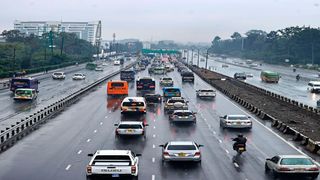
A section of Thika Superhighway on March 16, 2023. The hhighway recorded 155 deaths last year followed by Nairobi-Naivasha highway with 95 deaths.
| File| Nation Media GroupNews
Premium
Special report: Kenya’s deadliest roads and inside NTSA’s mega plan to reduce carnage by half
Thika Road and the Nairobi-Naivasha highway witnessed the most road fatalities last year, a report by the National Transport and Safety Authority (NTSA) shows.
The two overtook Outering Road and Northern Bypass as Kenya’s deadliest roads as over 4,000 road users lose their lives annually in the country.
According to NTSA data, the 50-kilometre Thika superhighway recorded 155 deaths across Nairobi and Kiambu counties, which it traverses, followed by Nairobi-Naivasha highway with 95 deaths.
Other roads with a high number of accidents were Outering, which recorded 54 fatalities, same as Mombasa-Nairobi highway, while the Nakuru-Eldoret highway had 50 deaths, Eastern Bypass 42, Nairobi-Nakuru highway 40, and Matuu-Thika highway 36. Waiyaki Way accounted for 29 deaths of 4,690 recorded on Kenyan roads last year with the Northern Bypass contributing 26 fatal crashes.

NTSA boss George Njao displays a copy of the National Road Safety Action Plan 2023-2027 at the Edge Convention Centre in Nairobi on Wednesday last week.
The report revealed that Nairobi, Kiambu, Nakuru and Machakos counties witnessed 1,454 deaths, representing 36 per cent of fatalities recorded last year.
Last year, Nairobi contributed 474 fatalities followed by Kiambu with 440, Nakuru 326 and Machakos 214.
NTSA Director-General George Njao said many crashes occur on the Northern Corridor, which drives the large percentage of fatalities. According to the NTSA, counties situated along the Northern Corridor stretching from Mombasa to Malaba account for 40 per cent of the 4,000 lives lost on Kenyan roads every year.

Onlookers view the wreckage of vehicles involved in a multiple crash involving six vehicles in Sachangwan in 2017.
“Five roads in Nairobi County, representing two per cent of the road network, account for 36 per cent of all fatal crashes in the country,” said Mr Njao. In terms of the road user group, the NTSA data reveal that pedestrians and motorcyclists are the most at risk, with motorcyclists accounting for 38 per cent, followed by pedestrians at 35 per cent and passengers 16 per cent while drivers account for nine per cent and cyclists two per cent.
To reverse the deadly trend, Mr Njao said NTSA is banking on a five-year initiative, dubbed “The National Road Safety Action plan 2023-2027”, to reduce the road fatalities by at least 50 per cent.
The blueprint has set out eight national strategic priorities and a timetable for action and results aimed at reducing deaths and serious injuries on the road.
Motorists will be expected to maintain speed limits as low as 30 kilometres per hour as part of a push for the introduction of a new speed limit system based on the function, use, and safety qualities of each road.
Also Read:Salgaa, where death is a slip away
The 30 km/h speed limit will apply where there is potential for collisions with pedestrians and cyclists, such as villages, school zones or commercial areas, same as where children mix with traffic.
A 50 km/h speed limit will apply where there is potential for side impact collisions, such as intersections while a 70 km/h limit will be expected in areas where there is potential for head-on collisions, such as undivided rural highways.
The plan will also see the introduction of a graduated licensing system for motorcycles. All boda boda operators will be required to join a Sacco with a minimum of 100 members, with the groups required to deposit their registration details with NTSA and county governments.
The blueprint also targets to develop a national road safety policy aligned with international commitments as well as establishing county transport and safety committees, each of which will develop their own county road safety action plans.
Outdated road design and operating standards will be replaced with standards that prioritise user safety over vehicle speed.

A roadblock mounted by traffic police officers in conjunction with the National Transport and Safety Authority along Langata Road, Nairobi.
“Current road designs prioritise the needs of motorised vehicles and do not adequately consider the safety of vulnerable road users such as cyclists, pedestrians, and motorcyclists,” said Mr Njao.
The five-year plan is also rooting for the establishment of the National Road Transport and Safety Fund as provided for by the NTSA Act to support road safety programmes.
According to the plan, 10 per cent of funding for capital road projects should be dedicated to road safety programmes.
Equally, all development partners and financing institutions for road infrastructure will allocate 10 per cent of all infrastructural costs to road safety.
Further, fuel levy allocation to road safety programmes will be increased to 10 per cent through relevant legislative and administrative actions. Other payments to the fund include monies appropriated by Parliament, grants and donations made to NTSA, and monies from a source approved by the agency.
Mr Njao said the fund creates an opportunity for NTSA to manage a dedicated road safety fund, which may be allocated across the critical areas of activity set out in the five-year plan, and in pursuit of the national road safety vision and targets.
Other areas to be supported through the fund include road safety management systems such as crash data, regulatory reforms, research and development, and training.
The plan also roots for a Nationwide Emergency Response system that links road crash victims to medical aid. The system is aimed at curbing deaths resulting from poor handling of patients by first responders.
The draft plan states that, while the country has an extensive network of health facilities with the major ones equipped with emergency units dedicated to crash victims, a gap occasioned by poor handling of crash victims continues to cause deaths that could have been avoided had proper emergency care been accorded at the scene of the accident.
“The injury severity and mortality rates are increased by poor treatment at the scene of the crash and as victims are transported from a crash scene to the hospital,” says the document.
To achieve this, an investment in good-quality emergency health services along high-risk corridors and areas prone to traffic accidents will be prioritised through a multi-agency approach involving county governments, the ministries of Health, Transport, and Interior, and other stakeholders.
- Additional reporting by Mary Wambui





